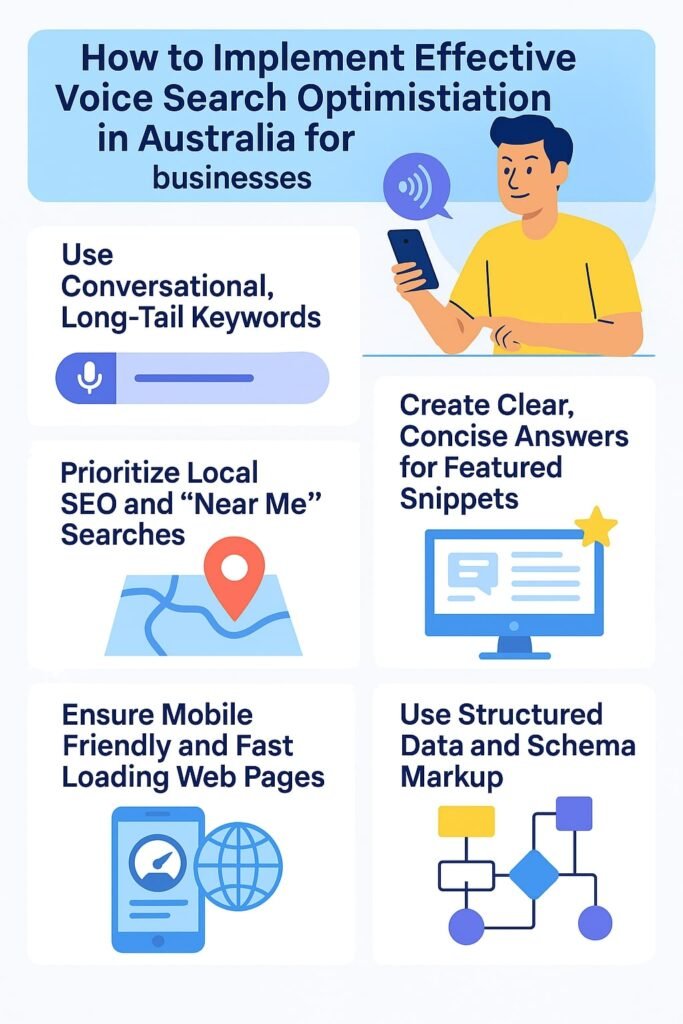
Voice Search vs. Text Search in Australia: Key Insights for Businesses
In 2025, the way Australians search online is evolving rapidly. Voice search is no longer a futuristic novelty—it has become a central part of digital interactions. With smart devices like Google Assistant, Siri, and Alexa integrated into homes, cars, and phones, businesses in Australia must embrace voice search optimisation, voice search and SEO, and SEO voice strategies to remain competitive and visible.
This blog dives deep into the key differences between voice and text search, why voice search demands a new SEO approach, and how Australian businesses can adapt effectively. Using cutting-edge SEO methods aligned with SXO, AEO, GEO, and AIO principles, this guide will position your business for growth in an increasingly voice-driven search world.
Understanding Voice Search vs. Text Search
Traditional text search involves entering brief, keyword-heavy phrases into search engines like Google—e.g., “best coffee Sydney.” These queries are often short and fragmented.
In contrast, voice search queries are:
- Conversational and natural, often phrased as questions
- Longer, mimicking everyday speech, e.g., “What is the best coffee shop near me in Sydney?”
- Focused on providing quick, direct answers
- Predominantly mobile or smart home device driven, supporting hands-free searches
This fundamental difference profoundly affects how businesses approach SEO—they need content optimized for natural language, local queries, and featured snippet-ready answers.
Why Voice Search Optimisation Matters for Australian Businesses
- Rapid User Adoption
Over 50% of internet searches globally are projected to be voice-based in 2025. In Australia, the rise in smart speaker ownership and mobile voice assistant use propels this change, with a growing share of consumers preferring the ease and speed of voice searches. - Highly Localised Search Behaviour
Voice search is primarily local. Australians frequently ask for nearby services and products via voice assistant devices. This means local SEO signals, Google Business Profile optimizations, and consistent NAP (Name, Address, Phone) data are critical for appearing in voice search results. - Mobile-Centric Experience
Most voice queries come from mobile devices, making page speed, responsive design, and intuitive user experience vital for SEO success. - Increased Visibility Through Rich Answers
Voice assistants pull from featured snippets, knowledge panels, and answer boxes. Optimizing content to appear in these rich answer formats can dramatically improve visibility in voice search results.
Key Differences Between Voice Search and Text Search for SEO
| Aspect | Voice Search | Text Search |
|---|---|---|
| Query Style | Conversational, question-oriented | Short, keyword-driven |
| Query Length | Longer, natural phrasing | Shorter, fragmented phrases |
| User Intent | Clear, immediate answers, usually local | Intent varies widely |
| Device Used | Mobile phones, smart speakers, wearables | Desktop and mobile browsers |
| Result Types | Featured snippets, direct answers | Organic listings, multiple links |
| Search Context | On-the-go, hands-free, local focus | More deliberate, desktop or mobile browsing |
How to Implement Effective Voice Search Optimisation in Australia
1. Focus on Conversational, Long-Tail Keywords
Use tools like Google’s “People Also Ask” and AnswerThePublic to identify natural phrases and questions your audience uses. Incorporate full question phrases like “How do I find a reliable plumber near me in Melbourne?” throughout your content.
2. Create Clear, Concise Answers for Featured Snippets
Answer common questions with precise, well-organized content near the top of pages, using bullet points and numbered lists. This increases chances of your business being the source of the voice assistant’s spoken answer.
3. Prioritize Local SEO and “Near Me” Searches
Optimize and verify your Google Business Profile. Ensure NAP details are consistent across online directories. Gather authentic positive reviews to improve local rankings.
4. Ensure Mobile Friendly and Fast Loading Web Pages
Improve your website’s mobile responsiveness and page speed, which Google highly weighs in voice search rankings.
5. Use Structured Data and Schema Markup
Deploy schema to help search engines interpret your business information, FAQs, and services, enabling enhanced display in voice search results.

The Role of AI and Generative Technologies in Voice Search and SEO Voice
AI and machine learning power voice technologies by improving understanding of contextual and conversational queries. For businesses, this means:
- Using AI-powered tools to generate natural language content and keywords
- Leveraging analytics to understand user intent behind voice queries
- Personalizing content based on audience preferences and behaviours
- Ensuring content complies with dynamic AI-driven ranking updates
Key Updates and Trends in Voice Search Optimisation for 2025
- Increasing prevalence of multi-modal voice assistants that show both visual and spoken answers
- Greater emphasis on privacy and personalisation, requiring businesses to adopt user-centric content approaches
- Enhanced local search prominence, meaning hyperlocal content and listings are more valuable than ever
- Focus on sustainability and values-driven content, as Australian consumers favor socially responsible brands
- Growth of FAQ-first content strategy reflecting common voice queries and quick answers
Trending FAQs on Voice Search Optimisation (Australia Focus)
Q1: What is voice search optimisation?
A1: It’s optimizing your website and content specifically to meet the demands of voice queries, which are conversational, question-based, and often local in nature.
Q2: How does voice search change SEO strategies?
A2: Voice search requires focusing on long-tail, natural language keywords, improving mobile performance, local SEO, and targeting featured snippets for direct answers.
Q3: Is voice search only from smart speakers?
A3: No. Voice search happens on smartphones, wearable devices, in-car systems, and smart home assistants.
Q4: How important is local SEO for voice search?
A4: Extremely important. Most voice searches have local intent, so up-to-date Google Business Profile info, accurate NAP data, and localised content are crucial.
Q5: Can small businesses compete in voice search against big brands?
A5: Yes. Local relevance, authentic customer reviews, and clear FAQ content can help small and medium businesses rank highly for voice queries.
Q6: How does voice search optimisation improve user experience?
A6: Optimizing for voice often improves mobile usability, page speed, and accessibility, benefiting all users.
Q7: What new tools can help with SEO voice in 2025?
A7: AI-powered SEO platforms for conversational keyword research, voice query analytics, and content generation are leading tools for voice optimisation.
Conclusion: Future-Proof Your Australian Business with Voice Search and SEO Voice Strategies
Voice search is transforming how Australians discover products, services, and information. Businesses failing to adapt risk losing visibility and market share. By embracing voice search optimisation, integrating conversational keywords, refining local SEO efforts, enhancing mobile experience, and structuring content for featured snippets, Australian businesses can capture this growing voice-first audience.
To get professional support tailored for your business and region, explore the expert SEO services offered by Jainam Infotech. Let your business be found—whether your customers speak or type their queries.